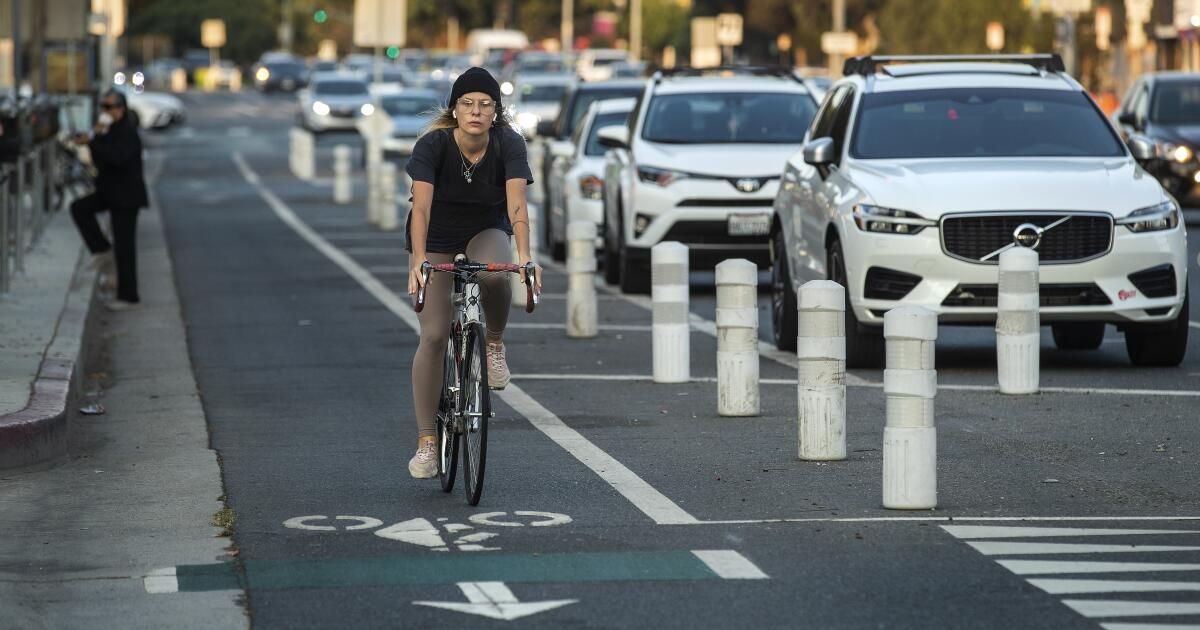When Los Angeles residents voted last year to implement the mobility plan of almost a decade of the city, transport security defenders called him a victory for pedestrians, cyclists and motorists from Los Angeles. The sidewalks would improve, traffic congestion would slow down and bicycle lanes and bus lanes would be updated and built.
But the scope of the HLA measure, the initiative of the entire city to continue with what the Council of the City of Los Angeles had adopted in 2015, has been in the center of a recent debate between defenders and Metro after the transit agency advanced in a project for the most busy bus route of the county without early plans for new bicycle lanes.
Transit defenders argue that the exclusion of the Vermont Avenue project ignores the mandate of voters to follow the mobility plan, which requires improving bicycle lanes in that street; Metro and city officials have responded that the measure was applied only to the city of Los Angeles, not to the traffic agency throughout the county.
“We do not believe it is legal,” said Michael Schneider, who directs the streets for all, the defense group behind the measure of the electoral ballot. “HLA is a city measure, and Metro is a county agency, but Vermont is owned by the city of Los Angeles, and the city is working with Metro. They allow it, they are providing technical experience, they are spending time and money from the staff. This falls under the measure of HLA, which requires a bicycle lane in vermont.”
Last week, the agency's board of directors voted to approve plans for Transit Vermont corridor, a project that will add dedicated bus lanes and 26 stations in 13 locations along a stretch of 12.4 miles in Vermont Avenue between 120th Street and Sunset Boulevard. The route sees 38,000 daily bus approaches, according to Metro, and is expected to increase to 66,000 by 2045.
The project is expected to improve traffic access for disadvantaged communities and a high number of residents that identify as black, indigenous and people of color, according to Metro. The corridor includes most low -income households, including residents without access to a car.
The project is included in the MEs MEASUREMENT PLAN, which allocated $ 425 million for construction.
“Metro supports HLA's objectives and objectives, specifically that we have worked, and we will continue working, with all local jurisdictions to provide a better quality traffic and safer streets for all Los Angeles County,” said the agency in a statement. “However, HLA does not apply to subway projects.”
The Board's vote did not include discussion and ignored the pleas of public commentators who asked Metro to reconsider their plans to include improved bicycle lanes.
The project has been under study for almost a decade. According to Metro, the incorporation of new bicycle lanes would delay the project up to five years, the cost and strength of the Metro would increase to acquire properties.
In a letter to Metro's executive director, Stephanie Wiggins, last month, Schneider played Metro's claims and said that the addition of bicycle lanes would not cause delays or properties would affect whether parking was not prioritized about updates. He warned that the plan without bicycle lanes would further compromise safety on the route for cyclists and pedestrians. Vermont Avenue sees one of the death counts and higher pedestrian injuries in the city, according to Metro and streets for all.
Metro has maintained its position. In a letter sent to the president of the Council of the City of Los Angeles, Harris-Dawson marks, last month, a subway lawyer said that the agency would take legal actions if the city forced her to comply with the HLA measure. The lawyer cited a letter that the city lawyer sent streets for all in November that said that the agency does not need to comply with the measure, a point that was reiterated at a meeting of the city transport committee in February.
The lawyer also indicated an agreement between the city and the Metro, which recognizes the “self -government authority” of the agency.
“He [agreement] It simply does not transform subway projects into city projects, ”says the letter.
Schneider and others have said that the agency's plan rules out the needs of residents.
“We have an epidemic of deaths and traffic injuries,” said Eli Lipmen, executive director of the Move Transit Defense Group “some of the issues have to do with how people conduct and conduct recklessly, but it has a lot to do with the lack of good infrastructure.”
Lipmen said that more people will hurt if Metro does not allow new lanes for protected bicycles in their plans and hopes there is still time to talk.
“Vermont must happen and should happen as soon as possible. We cannot delay this project in another second,” Lipmen said.
The project is expected to be completed by the 2028 Olympic Games.












